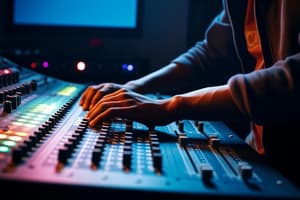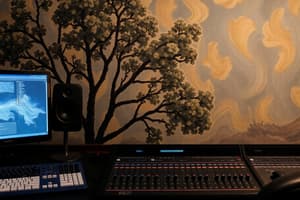Podcast
Questions and Answers
Which individual is primarily responsible for optimizing and combining multitrack recordings into a final mono, stereo, or surround sound product?
Which individual is primarily responsible for optimizing and combining multitrack recordings into a final mono, stereo, or surround sound product?
- Mastering engineer
- Record producer
- Mixing engineer (correct)
- Recording artist
What are some common processes applied to individual tracks during the audio mixing process?
What are some common processes applied to individual tracks during the audio mixing process?
- Stereo and surround sound adjustment
- Reverberation and delay
- Equalization and compression (correct)
- Pitch shifting and time-stretching
Where is audio mixing primarily performed?
Where is audio mixing primarily performed?
- Recording studio
- Mixing console or digital audio workstation (correct)
- Mastering studio
- Live concert venue
In the history of sound recording, who developed the first recording machines in the late 19th century?
In the history of sound recording, who developed the first recording machines in the late 19th century?
What has a significant influence on the final product of audio mixing?
What has a significant influence on the final product of audio mixing?
What technological advancement allowed for greater flexibility in the balance of recordings before the introduction of multitrack recording?
What technological advancement allowed for greater flexibility in the balance of recordings before the introduction of multitrack recording?
Which technology made it possible for recording studios to combine and treat sounds not only during recording, but also afterward during a separate mixing process?
Which technology made it possible for recording studios to combine and treat sounds not only during recording, but also afterward during a separate mixing process?
What did the introduction of the cassette-based Portastudio in 1979 offer in terms of recording and mixing technology?
What did the introduction of the cassette-based Portastudio in 1979 offer in terms of recording and mixing technology?
What is the primary role of a mastering engineer in the audio production process?
What is the primary role of a mastering engineer in the audio production process?
Which technology allows for greater flexibility in balancing recordings during the mixing process, other than multitrack recording?
Which technology allows for greater flexibility in balancing recordings during the mixing process, other than multitrack recording?
What key factor largely influences the audio mixing techniques used in the production of sound recordings?
What key factor largely influences the audio mixing techniques used in the production of sound recordings?
Who is generally responsible for carrying out the audio mixing process in a recording studio?
Who is generally responsible for carrying out the audio mixing process in a recording studio?
What was the primary technology utilized in Edison's phonograph cylinder system?
What was the primary technology utilized in Edison's phonograph cylinder system?
In the history of sound recording, what technological advancement allowed for greater flexibility in the balance of recordings before the introduction of multitrack recording?
In the history of sound recording, what technological advancement allowed for greater flexibility in the balance of recordings before the introduction of multitrack recording?
Which individual or band utilized the cassette-based Portastudio in 1979 for recording and mixing technology?
Which individual or band utilized the cassette-based Portastudio in 1979 for recording and mixing technology?
What was the major advancement that replaced tape-based recording for most home studios in the mid-to-late 1990s?
What was the major advancement that replaced tape-based recording for most home studios in the mid-to-late 1990s?
Flashcards are hidden until you start studying
Study Notes
- Audio mixing is the process of combining multitrack recordings into a final mono, stereo, or surround sound product.
- Process involves adjusting and balancing the relative levels of the tracks and applying processes like equalization and compression.
- Audio mixing techniques depend on music genres and recording quality.
- Thomas Edison and Emile Berliner developed the first recording machines in late 19th century using mechanical parts.
- Electronic recording became popular during the 1920s, allowing for greater flexibility in the balance and positioning of microphones.
- Before multitrack recording, all sounds were mixed live during performances.
- Multitrack recording changed the process into three stages: recording, overdubbing, and mixing.
- Commercial multi-track tape machines, such as 8-track recorders, introduced in the 1960s revolutionized the recording process.
- Portastudio, introduced in 1979, offered multi-track recording and mixing technology accessible to non-professionals.
- Computers replaced tape-based recording in the 1990s, and digital audio workstations (DAWs) became popular for recording and mixing.
- A mixer is the operational heart of the mixing process, offering a multitude of inputs for tracks from a multitrack recorder, and typically having 2 main outputs for stereo mixing or 8 outputs for surround sound mixing.
Studying That Suits You
Use AI to generate personalized quizzes and flashcards to suit your learning preferences.





